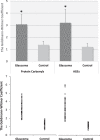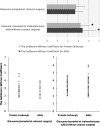Oxidative Stress-Related Molecular Biomarker Candidates for Glaucoma
- PMID: 28820925
- PMCID: PMC5685420
- DOI: 10.1167/iovs.17-22242
Oxidative Stress-Related Molecular Biomarker Candidates for Glaucoma
Abstract
Purpose: Glaucoma-related molecular biomarkers can improve clinical testing to diagnose the disease early, predict its prognosis, and monitor treatment responses. Based on the evidence of increased oxidative stress in glaucomatous tissues, this study analyzed oxidative stress-related biomarker candidates in blood and aqueous humor samples with or without glaucoma.
Methods: The blood and aqueous humor samples collected from carefully selected groups of 96 patients with glaucoma and 64 healthy subjects without glaucoma were included in the study. The samples were analyzed for protein carbonyls and advanced glycation end products (AGEs) through ELISA-based quantification assays. To allow proper comparisons, the Goldmann-Witmer coefficient that reflects the ratio of aqueous humor to blood values corrected to total protein concentration in individual samples was calculated.
Results: Blood and aqueous humor levels of protein carbonyls and AGEs were found significantly higher in glaucomatous samples compared with age-matched nonglaucomatous controls (P < 0.001). The glaucoma-related increase in protein carbonyls and AGEs was more prominent in aqueous humor samples than blood samples (2.6-fold versus 1.9-fold for protein carbonyls, and 3.1-fold versus 1.9-fold for AGEs; P < 0.001). Comparison of the Goldmann-Witmer coefficients indicated greater values for protein carbonyls (1.37 ± 0.3 vs. 3.07 ± 0.8) and AGEs (1.2 ± 0.3 vs. 3.2 ± 1.1) in the glaucoma group (P < 0.001).
Conclusions: Findings of this study encourage further validation studies of oxidative stress-related biomarkers in glaucoma. Analysis of protein carbonyls and AGEs in longitudinal studies of larger and heterogeneous patient cohorts should better assess the value of these promising candidates as molecular biomarkers of glaucoma for clinical predictions.
Figures






References
MeSH terms
Substances
Grants and funding
LinkOut - more resources
Full Text Sources
Other Literature Sources

